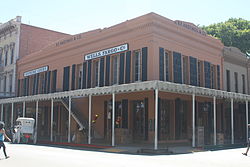
Sutter's Fort was a 19th-century agricultural and trade colony in the Mexican Alta California province. Established in 1839, the site of the fort was originally called New Helvetia by its builder John Sutter, though construction of the fort proper would not begin until 1841. The fort was the first non-indigenous community in the California Central Valley. The fort is famous for its association with the Donner Party, the California Gold Rush, and the formation of the city of Sacramento, surrounding the fort. It is notable for its proximity to the end of the California Trail and Siskiyou Trails, which it served as a waystation.

The Pony Express was an American express mail service that used relays of horse-mounted riders between Missouri and California. It was operated by the Central Overland California and Pikes Peak Express Company.

Old Sacramento State Historic Park occupies around one third of the property within the Old Sacramento Historic District of Sacramento, California. The Old Sacramento Historic District is a U.S. National Historic Landmark District. The Historic District is sometimes abbreviated as Old Sacramento, or Old Sac, and since the 1960s has been restored and developed as a significant tourist attraction.

The California State Capitol is the seat of the California state government, located in Sacramento, the state capital of California. The building houses the chambers of the California State Legislature, made up of the Assembly and the Senate, along with the office of the governor of California. The Neoclassical structure, designed by Reuben S. Clark, was completed between 1861 and 1874. Located at the west end of Capitol Park and the east end of the Capitol Mall, the building was added to the National Register of Historic Places in 1973. The California State Capitol Museum is housed on the grounds of the capitol.

The National Farmers' Bank of Owatonna, Minnesota, United States, is a historic bank building designed by Louis Sullivan, with decorative elements by George Elmslie. It was built in 1908, and was the first of Sullivan's "jewel box" bank designs. The building is clad in red brick with green terra cotta bands, and features two large arches on its street-facing facades. Single-story wings, originally housing bank offices, extend along each side. Internal elements include two stained-glass windows designed by Louis J. Millet, a mural by Oskar Gross, and four immense cast iron electroliers designed by Elmslie and cast by Winslow Brothers Company.

The Patee House, also known as Patee House Museum, was completed in 1858 as a 140-room luxury hotel at 12th Street and Penn in St. Joseph, Missouri. It was one of the best-known hotels west of the Mississippi River.

The Wells Fargo Building, originally the Fidelity-Philadelphia Trust Company Building, is a skyscraper in Center City, Philadelphia, Pennsylvania, United States. Designed in the Beaux-Arts style by the architectural firm Simon & Simon, the building was erected for the Fidelity-Philadelphia Trust Co. in 1928. The 30-story high-rise is listed on the National Register of Historic Places.

The Union Station, at 801 South 10th Street in Omaha, Nebraska, known also as Union Passenger Terminal, is "one of the finest examples of Art Deco architecture in the Midwest". Designated an Omaha Landmark in 1978, it was listed as "Union Passenger Terminal" on the National Register of Historic Places in 1971, and was designated a National Historic Landmark in 2016. The Union Station is also a contributing property to the Omaha Rail and Commerce Historic District. It was the Union Pacific's first Art Deco railroad station, and the completion of the terminal "firmly established Omaha as an important railroad terminus in the Midwest".

The Capitol Mall or Capitol Mall Boulevard is a major street and landscaped parkway in the state capital city of Sacramento, California. Formerly known as M Street, it connects the city of West Sacramento in Yolo County to Downtown Sacramento. Capitol Mall begins at the eastern approach to the Tower Bridge, and runs east to 10th Street and the California State Capitol.

Oak Grove Butterfield Stage Station is located in the western foothills of the Laguna Mountains, in northern San Diego County, California. It is located on State Route 79, 13 miles (21 km) northwest of Warner Springs and Warner's Ranch. The station was built on the site of Camp Wright, an 1860s Civil War outpost.

The Big Four Building is a historic 19th-century building in Downtown Sacramento, California. It is now located within Old Sacramento State Historic Park and the Old Sacramento National Historic District.

The Barbary Coast Trail is a marked trail that connects a series of historic sites and several local history museums in San Francisco, California. Approximately 180 bronze medallions and arrows embedded in the sidewalk mark the 3.8-mile (6.1 km) trail.
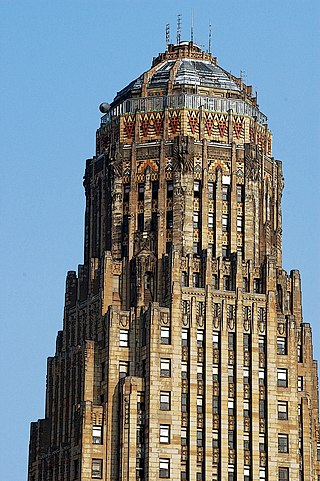
The Architecture of Buffalo, New York, particularly the buildings constructed between the American Civil War and the Great Depression, is said to have created a new, distinctly American form of architecture and to have influenced design throughout the world.
This list includes properties and districts listed on the California Historical Landmark listing in Sacramento County, California. Click the "Map of all coordinates" link to the right to view a Google map of all properties and districts with latitude and longitude coordinates in the table below.
The following is a timeline of the history of the city of Sacramento, California, United States.

The Wells Fargo History Museum is a museum operated by Wells Fargo in its corporate headquarters in San Francisco, California that feature exhibits about the company's history. Some of the museums' displays include original stagecoaches, photographs, gold nuggets and mining artifacts, the Pony Express, telegraphs and historic bank artifacts. The museum was initially known as the Wells Fargo History Room when it opened in 1927 in San Francisco. In 1935 a museum was opened for public tours. The museum has been operating for nearly 60 years in its current location.
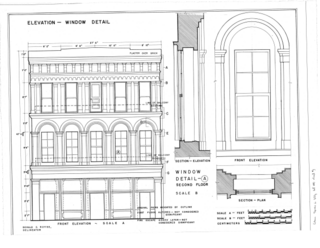
Adams and Company Building is an historical brick and granite building in Sacramento, California used for pioneer communications, finance and transportation servies. The Adams and Company Building is a California Historical Landmark No. 607. The Adams and Company Building is located at 1014 2nd Street in Old Sacramento State Historic Park. Adams and Company closed after its bank, Page, Bacon & Company failed in 1855.
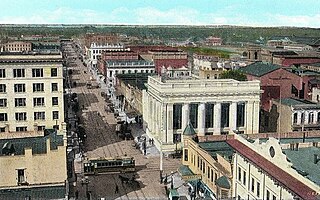
Mills Bank Building, also called the D. O. Mills Bank Building, is a historical bank in Sacramento, California, built in 1852 in Old Sacramento. It is a California Historical Landmark No. 609, registered on May 22, 1957. It was built by Darius Ogden Mills and was the oldest and largest bank of early California.
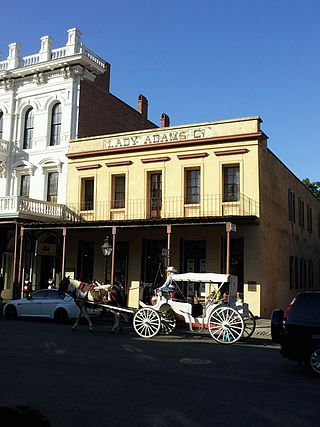
Lady Adams Building, is historical building in Sacramento, California. Lady Adams Building is a California Historical Landmark No. 603. Lady Adams Building was built in 1852 for $29,000 and opened as a store and office building. Lady Adams Building is the oldest building in Old Sacramento. The store specialized in goods from the East Coast of the United States that sailed through the Strait of Magellan in the brigantine sailing ship, Lady Adams. The building architect was Julius Fiedler. The building is at 113 K Street, Sacramento.

Pioneer Telegraph Station, is historical building in Sacramento, California. The building is a California Historical Landmark No. 366 listed on October 9, 1939. From 1863 to 1868 the building housed the State Telegraph Company. From 1868 to 1915 the building housed the Union Telegraph Company. The Pioneer Telegraph Station Building is part of the Old Sacramento State Historic Park. The Pioneer Telegraph Station Building is sometimes confused with the Pony Express Terminal building, also in Old Sacramento State Historic Park.
